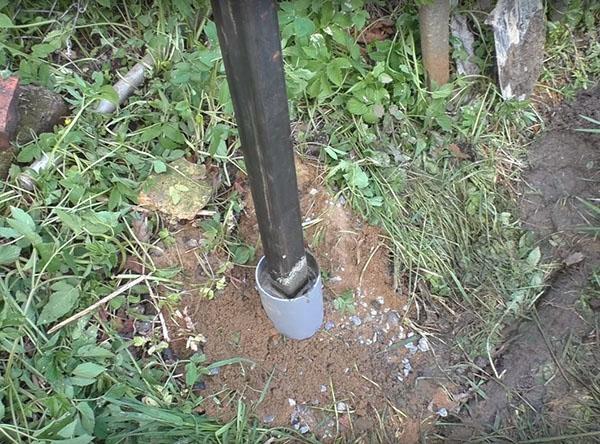We install the support posts of the fence for centuries
 A fence made of slate or mesh-netting is installed mainly in summer cottages. Such a fence is often uneven and fragile due to improper installation of the support pillars.
A fence made of slate or mesh-netting is installed mainly in summer cottages. Such a fence is often uneven and fragile due to improper installation of the support pillars.
It is better to use a square tube as support legs. You cannot save on support pillars. High-quality racks are a guarantee of a durable fence.
Metal pillars, over time, can rust, and the ground can settle. In order for the support post of the fence not to stick out from the ground in winter, when the soil freezes, concreting must be carried out using the technology of two diameters.
Using this technology, concrete solution is poured directly into a well with a diameter of 180 mm. Then the solution is filled with a fan pipe, put on the rack of the future fence. The diameter of the round tube is 110 mm. The external gap is filled with backfill.
Preparation of materials
In order to make a fence, you need to prepare tools and materials:
- A drill with a diameter of 18 cm.
- Profile pipe 50X50 with a wall thickness of 3 mm. The length of the pipe is 3.5 m. At a distance of 10 cm from the edge of the pipe, it is necessary to make a technological rectangular cut 10 cm long to fill it with concrete.
- A fan pipe with a diameter of 11 cm and a length of 85 cm. It will serve as formwork in the upper part of the well.
- Concrete solution and sand and gravel backfill.
The guide string is pulled between the corner posts.
The guide thread is pulled at a height of 1.9 m above the soil surface. Thus, it will turn out to install all the pillars flush with each other.
With the help of a plumb line, the centers of all are marked wells... They are drilled at the same distance from each other. The borehole depth should be 1.6 m.
Fence poles concreting
A rack is installed in the well, leveling it on both sides. The top of the post is aligned with the guide string. Then 70 cm of the well is poured with concrete.
A fan tube is put on the rack. The mortar is filled into the inner diameter of the formwork. Outside the formwork, the gap between the soil and the outer wall of the pipe is covered with a sand-gravel mixture.
The plastic pipe should be 15 cm higher than the ground level. Do not rush to fill the entire volume of the formwork with concrete. Pour the solution to a level with the soil, and after it dries and settles a little, add concrete to the edge of the pipe.
Concrete the rest of the racks using the same technology. Pour concrete mortar inside the profile pipe. This will prevent rainwater from entering the rack.